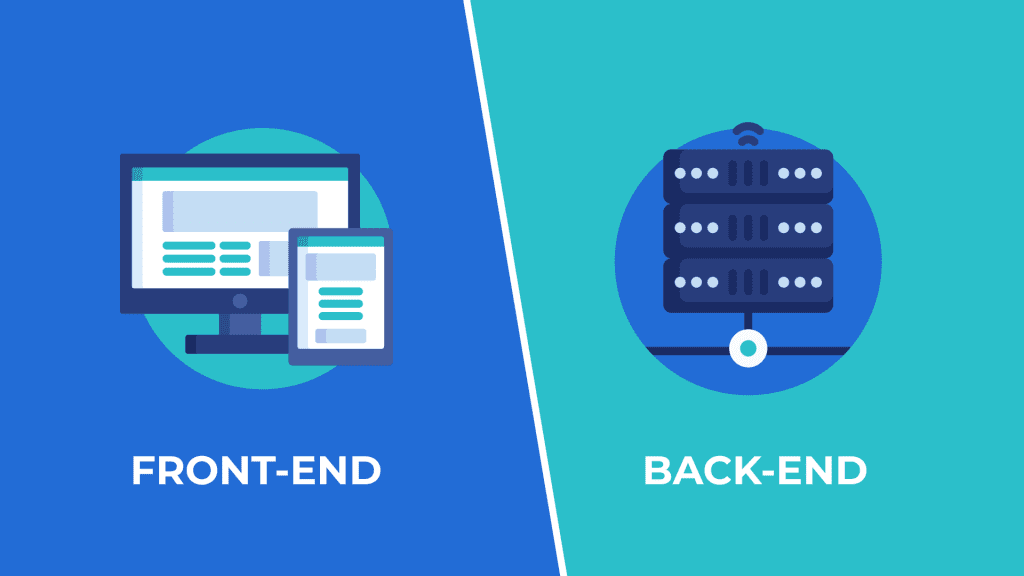In this article, you will get to know about the Difference Between Front-End vs. Back-End. The two most common terminology used in web development is front-end and backend. These words are crucial for web development even though they are very different from one another. Each side must work together and communicate with one another as a single unit to improve the website’s functionality.
Given how similar front-end and back-end development are in terms of ensuring that websites run effectively, the differences between them can be difficult to understand but through reading this article you can clarify between both. Front-end and back-end developers indeed collaborate to build the mechanisms required for an application or website to operate successfully. They do, however, have opposing worries.
Strong coding abilities are required for both kinds of developers. I have given a complete difference between front-end and back-end developers along with their skills, the tasks they do, their coding languages, framework, and libraries, whom they work with, and their average salary. Without further ado, let’s get started.
Table of Contents
ToggleTABLE OF CONTENT
- FRONT-END VS BACK-END
- HOW DO I BECOME A BACK-END DEVELOPER?
- WHAT IS NEEDED FOR FRONT-END DEVELOPMENT?
- WHAT DOES A FRONT-END DEVELOPER DO?
- WHAT DOES A BACK-END DEVELOPER DO?
- IS JAVASCRIPT FRONT END OR BACKEND
FRONT END VS BACK END
Both are equally important for a website but there are some differences between them. So, the following is the front-end vs back-end developer
FRONT-END DEVELOPER | BACK-END DEVELOPER |
| ||
DEFINITION
|
| |||
Front-end development is something that a user can see, interact with, and experience, as the names indicate. The website’s and applications’ user-visible components are programmed or coded. A front-end developer is someone who creates the front end. Building on the User Interface and User Experience designs, which are essential for bringing design to life, is the responsibility of a front-end developer.
|
Through the written programs, the back-end development analysis retrieves and sends the user’s actions back to the user. The individual who develops the back end is referred to as a “back-end developer.” A back-end developer’s primary task is to connect the databases and each component of the front end.
|
| ||
SKILLS
|
| |||
Front-End Developer Skills are:
· Analyze fascinating issues and create appealing answers. · Front-end developers benefit from having strong communication skills when working on online projects with clients and back-end developers. It could be necessary for developers to explain design challenges to clients who aren’t always tech-savvy. · HTML5-compliant static web pages should be designed, built, and modified. · To learn more about the user experience, examine a webpage’s client-side performance. · Websites with inventive front-end developers have better visual appeal and usability. They contribute to a site’s aesthetic appeal and usability beyond simple functioning. · The newest web technologies, such as HTML5, CSS3, JavaScript (ES6+), and React, can be used to design, develop, and deploy interactive and mobile-friendly web apps. · Combine such talents with back-end software like databases and Node.js, as well as with developer software such as Bash, Git, and automated testing. · Know how to cooperate and work well on a software project. Have interview confidence.
|
Back-End Developer Skills are
· To solve technical issues that arise during the establishment of a website, back-end development frequently calls for problem-solving abilities. Debugging and testing of back-end systems and apps may be among these jobs. · Improve your skills with a second, well-known programming language (Python 2 and 3), as well as Django, the language’s most popular web framework. · For straightforward algorithmic tasks, you should also appropriately use language features like lists, sets, and dictionaries. · For back-end engineers to finish projects successfully, good communication skills are a necessity. Web designers may need to communicate complex technical challenges to non-technical stakeholders. · learn how to interface with background technology like databases and servers, as well as how to solve progressively difficult puzzles. · Identifying and resolving web application performance issues. · Identifying and resolving web application performance issues. · In a sample application supplied, suggest a workable solution to a particular bottleneck. · Learn to create apps that are more competent, secure, reliable, and speedy.
|
| ||
TASKS
|
| |||
Front-end programmers create components like:
· Design and layout · Navigation · Images · Buttons · Putting the user experience first · Using HTML, CSS, and javascript to bring a notion to life · Creation and upkeep of websites and user interfaces for web applications · Constructing technologies that improve browser-independent site interaction · Implementing mobile site design · Keeping software workflow management up to date · Reviewing SEO recommended practices · Evaluating the usability of the website and repairing any bugs · Graphics · Animations · Content structure
|
Work that back-end web developers do includes: · Building codes · construction, integration, and maintenance of databases · Web server technologies back-end frameworks for developing server-side software · Internet of Things integration · programming languages for servers · running programs · creation, deployment, and maintenance of content management systems · integrating APIs · Security measures and prevention of hacking · producing analytics and data for reporting · methods for backing up and restoring a website’s files and database · Web application troubleshooting and debugging · database administration · use of the framework
|
| ||
PROGRAMMING LANGUAGES
|
| |||
· HTML- The general content and structure of a webpage are implemented using HTML. · JAVASCRIPT- The programming language JavaScript can be used to create a vibrant and lively website. You may use it, for instance, to host a game on your website. · The colors, style, layout, and fonts of a webpage are all created using CSS by front-end developers. To hasten the development process, these developers may employ CSS preprocessors like SASS or LESS.
|
· PHP- It is a scripting language used on servers.
· RUBY- It is a back-end programming language that is open-source and free. It allows back-end developers to swiftly develop new applications. Ruby comes with everything a website needs to function, therefore full-stack developers frequently utilize it as well. Ruby performs very well on busy websites. · JAVAA- It is a very popular platform and the programming language is Java. · PYTHON- A general-purpose programming language is Python. It varies from some of the others we’ve covered here in that it may be used for other forms of software development in addition to web development.
|
| ||
FRAMEWORK AND LIBRARIES
|
| |||
A front-end developer uses the following frameworks and libraries. · SASS · Bootstrap · jQuery · AngularJS · EmberJS
|
Among the back-end frameworks are: · Spring · Zend · Symfony · Django · Laravel CakePHP |
| ||
WORK WITH
|
| |||
· developers working on the back end · clients, management · business stakeholders
|
· business stakeholders · management · front-end developers
|
| ||
AVERAGE SALARY
|
| |||
$75,440
|
$81,160 | |||
If you want to know about technology career so read this article: Is technology a good career path.
How do I become a back-end developer?
Learning programming or scripting language is the greatest method to get started on the road to becoming a backend developer. Many job postings for back-end developers will list the following skills: Python, JavaScript, SQL, and PHP.
Most back-end developers have bachelor’s degrees in computer science, web development, programming, or a closely related discipline. Some organizations take on back-end developers that have completed boot camps, certification courses, or work experience to hone their skills. The back-end developer skills that I have mentioned also play a role in becoming one.
What is needed for front-end development?
Front-end development needed things include HTML, JavaScript, and CSS along with the skills that I have mentioned above for doing the tasks of front-end development. Frameworks and libraries like jQuery, AngularJS, SASS, Bootstrap, and EmberJS are also used by front-end developers.
The top front-end developers demonstrate originality, effective communication, and cutting-edge technological proficiency.
What does a front-end developer do?
A front-end developer’s primary duty is to make sure that users of the website can easily interact with the page. They accomplish this by combining programming, design, and technology to code a website’s aesthetic and take care of debugging.
When you visit a website, everything you see, click on, or use is the result of front-end developers’ work. Common tasks they do include:
- Improving user experience.
- Bringing concepts to life with the use of HTML, javascript, and CSS.
- The development and maintenance of the user interface.
- Putting the design into practice on mobile websites.
- Making technologies that enhance browser-independent site interaction
- Control over software workflow.
- Adhere to SEO best practices.
- Bug fixes and usability tests.
What does a back-end developer do?
The core code for a website or application is written by a back-end developer. The professionals that manage and construct the technologies that allow websites to process data and carry out operations are known as back-end developers.
Data storage, security, and other hidden server-side operations are all handled by back-end developers. Common tasks they do include:
- Building or maintaining databases
- Establishing APIs and ensuring that they communicate with the front end
- Using server-side language to provide the front end with more depth
- Works to increase the application’s or website’s overall security
Is javascript front end or backend
JavaScript is frequently used in front-end development, but in more recent times, in back-end development, JavaScript is also used. That is made feasible by the backend functionality provided by Node.js, a JavaScript runtime.
CONCLUSION:
The conclusion of the Difference Between Front-End vs. Back-End is that websites are made up of two parts: the front end, which users see, and the back end, which is the background code that supports the front end. Front-end developers design the fonts, colors, and styles that users interact with on websites.
The intangible framework that enables websites to operate properly is built by back-end developers. Front-end developers earn less money than back-end developers since they have a distinct set of technical talents. Back-end developers receive an average salary of $81,160, while front-end developers have an average salary of $75,440.
Their tasks and skills might be different from each other but in the end, both front-end and back-end web development work together to produce engaging, aesthetically beautiful websites and both are equally important for a website.




3 Responses
whoah this blog is magnificent i really like reading your articles.
Stay up the great work! You understand, a lot of people are looking round for this information,
you can aid them greatly.